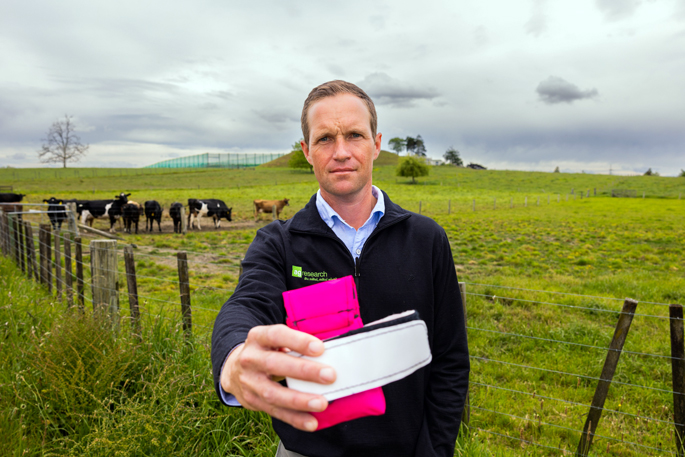It’s a wee issue but with a big environmental impact; and a new award-winning technology developed by AgResearch may help farmers to address it.
Scientists at the research institute have developed what they call acoustic urine sensors to tackle the problem of nitrogen loss from the urine of cattle, which affects water quality and leads to emissions of nitrous oxide, a potent greenhouse gas.
The device attaches to the rear leg of dairy cattle to enable recording and identification of distinct sound patterns in “urination events”, including timing and volume. Data from the recordings is analysed using technologies that include machine learning.
Dairy cows typically urinate 10-12 times per day with an average urination volume of two litres per event and an average equivalent urinary nitrogen application rate estimated to be approximately 600kg of nitrogen per hectare.
“Our research has shown that the nitrogen load of an individual urination event is closely connected with daily urination frequency, the time of day and the volume of the urination event,” says AgResearch senior scientist Brendon Welten.
“This means that urination frequency and volume per event directly affects the amount of nitrogen deposited in urine patches on the pasture.
“Therefore, cows that urinate more frequently per day coupled with a lower volume per urination event tend to excrete lower amounts of nitrogen per urination event and so represent a lower risk to the environment.”
This knowledge has led to AgResearch developing the concept of an environmental nitrogen herd test to identify and manage cows based on urinary-nitrogen loss potential.
The concept is similar to routine herd testing for milk quality and production; with a service provider deploying the urine sensor technology on a dairy farm to provide an accurate estimate of an individual cow’s urination frequency and volume per event.
This informs the urinary nitrogen loss potential of individual cows in the dairy herd.
“Once farmers have this farm-specific urinary nitrogen loss information of their dairy herd, this could be used in a decision support tool like Overseer to allow potential immediate benefits in reducing farm nitrogen loss relative to using a default model value.
“Furthermore, farmers can then use it to make farm management decisions, such as breeding and culling, to move their dairy herd towards lower nitrogen loss potential and thereby provides the opportunity to achieve sustained reductions (year on year) in farm nitrogen leaching loss.”
Last week, the research behind the sensor development was recognised when AgResearch’s Cattle Urine Sensor team won the Science and Technology Award at the 2023 Kudos Awards in Hamilton.
“It’s fantastic to have that recognition given over five years of development,” Dr Welten says.
“The benefits of these sensors are that they are lightweight, simple to use and low-cost. Their use can be easily scaled up and requires no capital investment in farm infrastructure, with minimal effect on daily farm management practices.
“Our current research is assessing farm-level benefits of this concept on farm nitrogen loss using case-study dairy farms linked with modelling funded by the Ministry for Primary Industries.
“We are looking forward to the potential large scale adoption of this concept in the future by New Zealand dairy farmers as a new tool to mitigate farm nitrogen loss.”



0 comments
Leave a Comment
You must be logged in to make a comment.